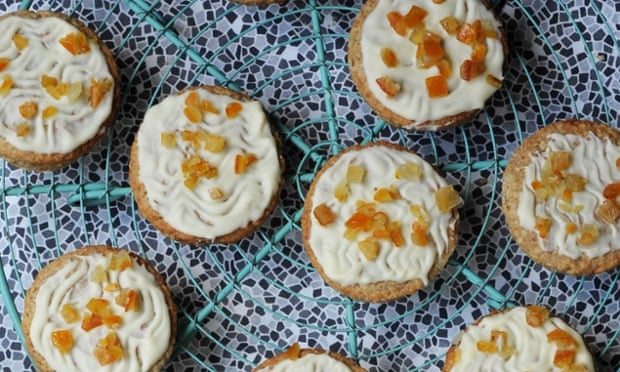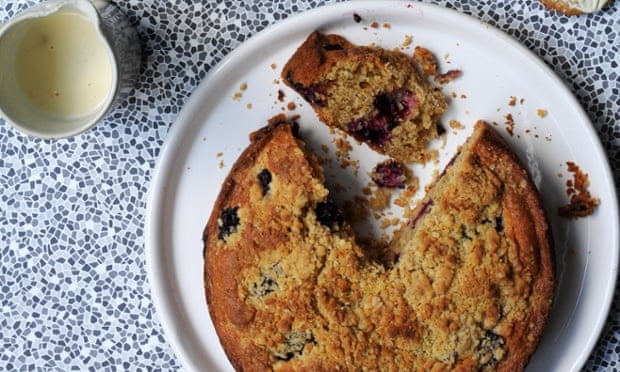Here’s a gallery of photos of some of the dishes we were served at lunches and dinners during my 16-day China Garden Tour from Shanghai to Beijing calling at Suzhou, Guilin, Xian and Luoyang.
Welcome To The Food World!!!
Tuesday, April 28, 2015
Monday, April 6, 2015
Beyond the flapjack: baking with oats
There’s a lot more to oats in baking than
flapjacks. They can lend body, texture and a subtle flavour to cakes and
biscuits, a pleasing robustness to a tin loaf or a crunch to crumble topping.
There’s no need to shell out for the good oats, either. In fact, the cheaper the
oat, the better your results will be. Fat, steel-cut rolled oats, jumbo oats,
organic Scottish porridge oats – each of these will take too long to hydrate in
doughs and batters, leaving the finished thing oddly chewy, bitty and dry. Stick
with the bog-standard oats that are part broken and dusty in their packet.
White chocolate honey oat biscuits
These are much like
Hobnobs – oaty, rubbly and butter-rich, though here daubed with white chocolate
to pair with the honeyed sweetness of the biscuit. You can swap in dark
chocolate if you’ve less of a sweet tooth, or forgo the chocolate altogether if
you’re a purist in these things.
The key to a crisp
finish is in the bake: too long and they’ll quickly brown and become bitter,
cook for too short a time and they’ll quickly soften and crumble. Bake in
batches if you’re not sure about how well heat circulates in your oven, and swap
shelves mid-bake if necessary.
The key to a crisp
finish is in the bake: too long and they’ll quickly brown and become bitter,
cook for too short a time and they’ll quickly soften and crumble. Photograph:
Jill Mead for the Guardian
Makes around
30
100g plain flour
100g wholemeal flour
75g caster sugar
1 tsp baking powder
A pinch of salt
150g unsalted butter, firm but not chilled
150g porridge oats
4 tbsp honey
1-2 tbsp milk
250g white chocolate
25g candied ginger or orange peel, finely chopped (optional)
100g plain flour
100g wholemeal flour
75g caster sugar
1 tsp baking powder
A pinch of salt
150g unsalted butter, firm but not chilled
150g porridge oats
4 tbsp honey
1-2 tbsp milk
250g white chocolate
25g candied ginger or orange peel, finely chopped (optional)
1
Preheat the oven to 180C/350F/gas mark 4. Line a couple of large baking trays
with baking parchment.
2
Combine the plain and wholemeal flours, caster sugar, baking powder and salt in
a large bowl. Cube the butter and add to the bowl then use your fingertips to
rub it into the dry ingredients, working quickly but lightly until there are no
chunks of butter left and the mixture is sandy. Stir in the oats.
3
Whisk the honey with 1 tbsp milk then pour into the dry ingredients. Use a small
knife to “cut” the liquid into the mix, working until no dry flour remains and
the dough is beginning to clump.
4
Gather the dough together, pressing into a flattish disc. Roll out on a lightly
floured work surface until it’s 5mm thick. If the dough’s too sticky to roll,
wrap it in clingfilm and refrigerate for 20-30 minutes before continuing; if
it’s too dry to hold together, add the remaining milk. These biscuits are
supposed to be rubbly and crumbly, so it’s important not to overwork the dough,
a couple of light kneads under the heel of your palm can help to give it the
strength to hold its shape during rolling and baking.
5 Use
a 6cm round pastry cutter to stamp out the biscuits, then arrange these on the
prepared baking trays. Gather up any offcuts, re-roll and cut out the
extras.
6
Bake for 12-13 minutes in batches, rotating the shelves halfway through if
you’re not using a fan oven. They’re done when the edges are just on the cusp of
browning. Leave to cool before moving the biscuits.
7
Once the biscuits are ready, melt the white chocolate in a heavy bowl propped
over a pan of simmering water. Use a silicone pastry brush to spread the top of
each biscuit liberally with the melted chocolate. Decorate with finely chopped
candied ginger or orange peel while the chocolate’s still wet. Alternatively,
just run a fork gently through the chocolate as it sets to mark a wiggly pattern
in it. Leave to cool before storing in an airtight container.
Blackberry oat crumble cake
There’s a double dose
of oats in this comfort cake: in the batter, creating a nutty, tender crumb, and
in a buttery crumble on top. It’s very autumnal in feel – blackberries,
cinnamon, toffee-ish brown sugar and hearty oats – but I can’t see any reason
why it can’t be enjoyed now, too, on cooler days when spring slips back into
drizzle and dreariness. It’s the kind of cake to be eaten still warm from the
oven, with custard, from under a duvet.
Serves
8
150g unsalted butter, softened
125g soft light brown sugar
3 large eggs
50g porridge oats
125g plain flour
2 tsp baking powder
½ tsp cinnamon
¼ tsp salt
150g-200g blackberries, halved
150g unsalted butter, softened
125g soft light brown sugar
3 large eggs
50g porridge oats
125g plain flour
2 tsp baking powder
½ tsp cinnamon
¼ tsp salt
150g-200g blackberries, halved
For
the crumble topping
50g plain flour
50g porridge oats
50g soft light brown sugar
50g unsalted butter, softened
50g plain flour
50g porridge oats
50g soft light brown sugar
50g unsalted butter, softened
1
Preheat the oven to 180C/350F/gas mark 4. Grease a 20cm round springform cake
tin and line the base with baking parchment.
2
Beat the butter and sugar together in a large bowl for 3-5 minutes, working the
mixture until very light and creamy. If you slack now, you’ll find the mixture
will really clump and curdle when you come to add the eggs. Whisk the eggs, one
at a time, into the butter and sugar, followed by the oats. In a separate bowl,
stir the flour, baking powder, cinnamon and salt together, then add this to the
wet ingredients. Fold lightly together then mix in the blackberries, taking care
not to squash the fruit as you go.
3 For
the crumble topping, combine the flour, oats and sugar in a bowl then add the
butter in small pieces. Rub the butter into the dry ingredients using your
fingertips. Don’t worry if the mixture feels a little sticky or greasy. With a
high proportion of butter in the mix, the crumble should quickly come together
in small clumps.
4
Spoon the batter into the prepared cake tin and level with a spatula. Sprinkle
the crumble all over the top, then place in the oven. Bake for 30-40 minutes, or
as long as it takes for the cake to rise, brown and set through. Leave to cool
completely before serving. Works particularly well with custard.
Subscribe to:
Comments (Atom)


















